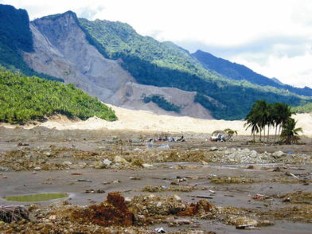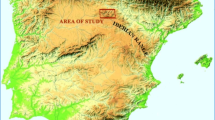Abstract
The paper presents a synthesis of the key findings of the conference and workshop convened to consider the causes of and lessons to be learned from the disastrous rockslide-debris avalanche on 17 February 2006 in southern Leyte, Philippines. Some 1,221 people died and the barangay of Guinsagon was buried. The geology, historical seismicity, progressive disintegration of the rock mass, development of smectite layers and the continuous development and movement of shears within the Philippine Fault Zone combine in the steep rugged terrain to produce massive landslides, of which the 15 million m3 Guinsaugon event was the latest. The relevance of recent heavy rain and an almost synchronous seismic event are considered but it is concluded that the movement was the result of progressive failures and tectonic weakening while the landslide hazard was increased by the presence of rice paddy fields in the valley bottom. An anecdotal time to failure curve is presented, based on eyewitness accounts and observations of instability. Attention is drawn to the importance of both the education and training of the local people in the recognition of signs of potential movement and a reporting management system. Such simple measures could save lives and empower local communities to take some ownership of their level of landslide risk.















Similar content being viewed by others
References
Allen CR (1962) Circum-Pacific faulting in the Philippines–Taiwan region. J Geophys Res 67:4795–4812
Aurelio MA (1992) Tectonique du segment central de al faille Philippine (etude structurale, cinèmatique et evolution geodynamique). These de Doctorat, Universite Pierre et Marie Curie, Paris, France, p 500
Aurelio MA (2000) Shear partitioning in the Philippines: constraints from Philippine fault and global positioning system data. Isl Arc 9:584–597
Aurelio MA, Barrier E, Gaulon R, Rangin C (1997) Deformation and stress states along the central segment of the Philippine fault: implications to wrench fault tectonics. J Asian Earth Sci 15:107–119
Barrier E, Huchon P, Aurelio MA (1991) Philippine fault: a key for Philippine kinematics. Geology 19:32–35
Bautista MLP, Oike K (2000) Estimation of the magnitudes and epicenters of Philippine historical earthquakes. Tectonophysics 317:137–169
Cardiel GG, Belleza GV, Guillerma JTA, LLagas ML, Evangelista D, Dupio A (2008) Kinematics of slope mass failure at the zone of initiation, Guinsaugon slide, St. Bernard, Southern Leyte. In: Proceedings of the international conference–workshop on the 17 February 2006 Guinsaugon landslide, 28 April–02 May, Tacloban, Philippines, TS1-O05
Catane SG, Cabria HB, Tomaron CP, Saturay RM, Zarco MAH, Pioquinto WC (2007) Catastrophic rockslide-debris avalanche at St. Bernard, southern Leyte, Philippines. Landslides 4:85–90
Catane SG, Cabria HB, Zarco MAH, Saturay RM, Mirasol-Robert AA (2008) The 17 February 2006 rock slide-debris avalanche, southern Leyte, Philippines: deposit characteristics and failure mechanism. Bull Eng Geol Env 67:305–320
Cole J, McCabe R, Moriarty T, Malicse JA, Delfin FG, Tebar H, Ferrer HP (1989) A preliminary Neogene palaeomagnetic data set from Leyte and its relation to motion on the Philippine fault. Tectonophysics 168:205–221
Cornforth DH (2005) Landslides in practice: investigation, analysis and remedial/preventative options in soils. John Wiley and Sons, New Jersey, p 596
Corominas J (1996) The angle of reach as a mobility index for small landslides. Can Geotech J 33:260–271
Daag A, Perez J, Solidum R, Jiorgio R, Caniete N (2008) Contribution of small magnitude earthquake to the Guinsaugon landslide. In: Proceedings of the international conference–workshop on the 17 February 2006 Guinsaugon landslide, 28 April–02 May, Tacloban, Philippines, TS1-O07, 2008
Domasig WF (1991) Report on the ground investigation of reported landslides and ground fissures and other earthquake-related damages in Cabalian–St. Bernard area in southern Leyte. Memorandum report, Philippines mines and geosciences development service, p 6
Duquesnoy T (1997) Contributions de la géodésie à l’étude de grands décrochements actifs associés à des zones de subduction à convergence oblique. Thése de docteur en sciences, University of Paris XI, Orsay
Duquesnoy T, Barrier E, Kasser M, Aurelio MA, Gaulon R, Punongbayan RS, Rangin C, the French–Philippine Cooperation team (1994) Detection of creep along the Philippine fault: first results of geodetic measurements on Leyte island, central Philippine. Geophys Res Lett 21:975–978
Evans SG, Guthrie RH, Roberts NJ, Bishop NF (2007) The disastrous 17 February 2006 rockslide-debris avalanche on Leyte island, Philippines: a catastrophic landslide in tropical mountain terrain. Nat Hazards Earth Syst Sci 7:89–101
Futalan KM, Biscaro JRD, Saturay RM, Catane SG (2008) Stratigraphy of the Guinsaugon landslide source area, southern Leyte, Philippines. In: Proceedings of the international conference–workshop on the 17 February 2006 Guinsaugon landslide, 28 April–02 May, Tacloban, Philippines, TS1-P01
Haber RN, Haber LR (2000) Experiencing, remembering and reporting events: the cognitive psychology of eyewitness testimony. Psychol Public Policy Law 6:1057–1097
Hart J, Hearn G, Chant C (2002) Engineering on the precipice: mountain road rehabilitation in the Philippines. Q J Eng Geol 35:223–231
Hungr O (1995) A model for the runout analysis of rapid flow slides, debris flows and avalanches. Can Geotech J 32:610–623
Hungr O, Evans SG (2004) Entrainment of debris in rock avalanches: an analysis of a long run-out mechanism. Geol Soc Am Bull 116:1240–1252
Hungr O, Evans SG, Bovis MJ, Hutchinson JN (2001) A review of the classification of landslides of the flow type. Environ Eng Geosci 7:221–238
Katz Y, Weinberger R, Aydin A (2004) Geometry and kinematic evolution of Riedel shear structures, Capitol Reef National Park, Utah. J Struct Geol 26:491–501
Keefer DK (1984) Landslides caused by earthquakes. Geol Soc Am Bull 95:406–421
Kilburn CRJ, Petley DN (2003) Forecasting giant, catastrophic slope collapse: lessons from Vajont, northern Italy. Geomorphology 54:21–32
Korup O (2004) Geomorphic implications of fault zone weakening: slope instability along the Alpine fault, south Westland to Fiordland, New Zealand. J Geol Geophys 47:257–267
Lagmay AMF, Tengonciang AMP, Marcos HV, Pascua CS (2003) A structural model guide for geothermal exploration in ancestral Mount Bao, Leyte, Philippines. J Volcanol Geotherm Res 122:133–141
Lagmay AMF, Ong JBT, Fernandez DFD, Lapus MR, Rodolfo RS, Tengonciang AMP, Soria JLA, Baliatan EG, Quimba ZL, Uichianco CL, Pagluican EMR, Remedio ARC, Lorenzo GRH, Valdivia W, Avila FB (2006) Scientists investigate recent Philippine landslide. Eos 87:121–124
Lagmay AMF, Tengonciang AMP, Rodolfo RS, Soria JLE, Baliatan EG, Paguican ER, Ong JBT, Lapus MR, Fernandez DFD, Quimba ZP, Uichanco CL (2008) Science guides search and rescue after the 2006 Philippine landslide. Disasters 32:416–433
Lanuza AG, Chu AV, Mangao EA, Soneja DS, Sanez R, Garcia DC (1994) Aftershocks observation of 05 July 1994 earthquake in Cabalian area, southern Leyte, PHIVOLCS internal report, p 35
Makino M, Mandanas AA, Catane SG (2007) Gravity basement of the Guinsaugon landslide along the Philippine fault zone. Earth Planets Space 59:1067–1071
Orense RP, Sapuay SE (2006) Preliminary report on the 17 February 2006 Leyte, Philippines landslide. Soils Found 46:685–693
Pascua CS, Catane SG, Zarco MAH, Cabria HB, Saturay RMS (2008) Mineralogical characteristics of the Guinsaugon landslide gouge and its implications on the failure mechanism. In: Proceedings of the international conference–workshop on the 17 February 2006 Guinsaugon landslide, 28 April–02 May, Tacloban, Philippines, TS1-O06, 2008
Petley DN, Higuchi T, Petley DJ, Bulmer MH, Carey J (2005) Development of progressive landslide failure in cohesive materials. Geology 33:201–204
PHIVOCS (2006) Earthquake wave data accessed online: http://www.phivolcs.dost.gov.ph/Earthquake/LatestEQ/2006/20060217_0236.htm
Punongbayan RS, Arboleda RA, Bornas MV, Abigania MT (2000) The 3 August 1999 Cherry hills landslide in Antipolo City, Philippines. Landslide News 13:12–15
Riedel W (1929) Zur mechanic geologischer brucherscheinungen. Zentral-blatt fur Mineralogie, Geologie und Paleontologie B: 354–368
Sajona FG, Bellon H, Maury RC, Pubellier M, Quebral RD, Cotten J, Bayon FE, Pagado E, Pamatian P (1997) Tertiary and quaternary magmatism in Mindanao and Leyte (Philippines): Geochronology, geochemistry and tectonic setting. J Asian Earth Sci 15:121–153
Sassa K, Fukuoka H, Soridum R, Wang G, Marui H, Furumura T, Wang F (2009) Mechanism of the initiation and motion of the 2006 Leyte landslide, Philippines (this issue)
Suwa H (2006) Catastrophe caused by the 17 February 2006 southern Leyte landslide in Philippine. J Jpn Soc Nat Disaster Sci 25:83–97
Velasco AA, Ammon CJ, Lay T, Hagerty M (1996) Rupture process of the 1990 Luzon, Philippines (M w = 7.7), earthquake. J Geophys Res 101 B10:22419–22434
Voight DJ (1988) A method for prediction of volcanic eruptions. Nature 332:125–130
Yamanaka Y (2006) Website EIC note of seismology, Earthquake Research Institute, University of Tokyo, 23 February 2006. In: Suwa H (2006) Catastrophe caused by the 17 February 2006 southern Leyte landslide in Philippine. J Jpn Soc Nat Disaster Sci 25: 83–97
Acknowledgments
The authors acknowledge the contributions from approximately 160 scientists, survivors, students and local elected officials who participated in the 2008 Guinsaugon conference and workshop, Leyte Island Philippines. The conference was convened by the University of Philippines and the University of Waterloo, and we acknowledge financial assistance from the National Science and Engineering Research Council of Canada, the city of Tacloban and the municipality of Saint Bernard. Finally this paper is respectfully dedicated to the memory of the people who lost their lives in the Guinsaugon landslide.
Author information
Authors and Affiliations
Corresponding author
Rights and permissions
About this article
Cite this article
Guthrie, R.H., Evans, S.G., Catane, S.G. et al. The 17 February 2006 rock slide-debris avalanche at Guinsaugon Philippines: a synthesis. Bull Eng Geol Environ 68, 201–213 (2009). https://doi.org/10.1007/s10064-009-0205-2
Received:
Accepted:
Published:
Issue Date:
DOI: https://doi.org/10.1007/s10064-009-0205-2




